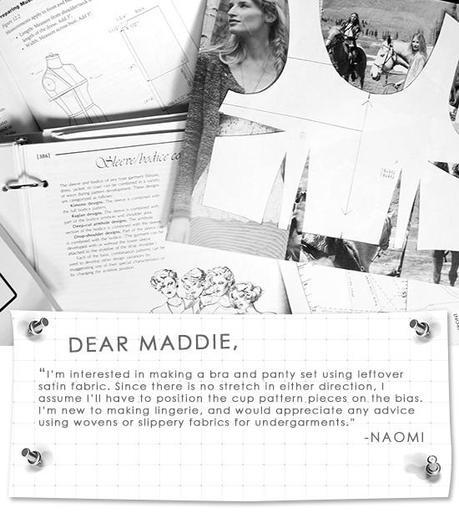
For me, one of the scariest things about sewing lingerie was the fabric. Spandex? Lycra? Nylon? Oh me, oh my, I didn’t want to go there. Just like Annie Oakley, I wanted to stick to my guns – woven fabrics. I knew them (wovens) like the back of my hand and was scared to trespass on stretchy territory. Although I’ve developed a hand for stretch material – actually, I now prefer sewing bras with them – I started out using wovens, which made the plunge into bra making less severe. The trick for a bra fitting using a woven fabric is knowing why and how to use their mechanical stretch – the bias.
First thing is to understand the concept of “direction of greatest stretch,” or DOGS. In wovens, grainline is used to indicate the direction of the fabric that has the least amount of stretch, and in most cases, patterns are aligned using this line. In bra making, it is the opposite, the marker for laying out patterns is according to the “direction of greatest stretch.”
Knowing this, I can now say that in almost all cases, the band of the bra must have stretch running around the body (the DOG is perpendicular to the hook and eye), because if it doesn’t, the wearer won’t have room to breath. I once made a bra in which the DOGS was parallel to the hook and eye, and every time I took a breath in, I wasn’t suffocated, but I was constricted. After a full day of wearing that bra, I wanted to rip it off and throw it in the trash (which I did!). Also to note, because the band must stretch, it is not stabilized with a tricot or a fusible like the bridge and cups (more on that next).
Opposite to the band, the bridge must be stable from side to side and from top to bottom. The band is where the support of a bra comes from, so while we allow the back band to stretch for breathing, we stabilize the front band, or the bridge, so that it can support the breasts, which sit right above it. Stabilizing the bridge in all directions is done in two steps. First, the DOG is placed parallel to the CF (so the stretch is running up and down and not side to side), and then a tricot or a fusible is added (which eliminates the stretch of the DOG that was running up and down).
When it comes to the cups, the placement of the DOGS varies depending on the type of support needed and that’s a whole other post for a whole other day, but ninety percent of the time, the DOGS runs parallel to the neckline in the upper cup and vertically on the lower cup. The weight of the breast moves in the direction of greatest stretch, so with this placement, the breast mass is pushed closer to CF on the upper cup, which makes a more youthful appearance, and down on the lower cup. Also, if using a stripe, the DOGS placement on the lower cup will allow for the lines of the pattern to hit the cross cup seam at an attractive angle – perpendicularly.
With this knowledge, you now know how to use your woven fabrics to make a beautiful and functional bra. Place the bias, which in a woven is the DOGS, perpendicular to the hook and eye for the band, parallel to the CF for the bridge, parallel to the neckline edge for the upper cup, and vertically on the lower cup.

